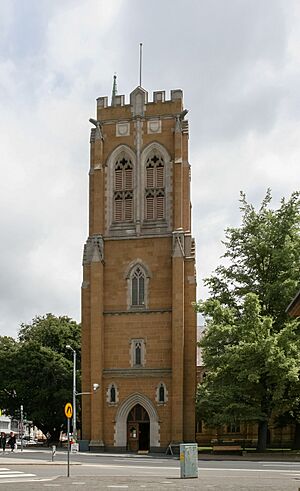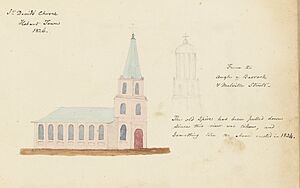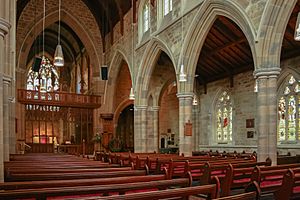St David's Cathedral, Hobart facts for kids
Quick facts for kids St David's Cathedral |
|
|---|---|
| Cathedral Church of St David | |

St David's Cathedral from Macquarie Street
|
|
| 42°53′01″S 147°19′43″E / 42.8835°S 147.3285°E | |
| Country | Australia |
| Denomination | Anglican |
| History | |
| Status | Cathedral (since 1848) |
| Founded | January 1868 |
| Founder(s) | Prince Alfred, Duke of Edinburgh |
| Dedication | Saint David |
| Consecrated | 1874 |
| Architecture | |
| Architect(s) | George Frederick Bodley |
| Architectural type | Church |
| Style | Gothic Revival |
| Years built | 1868 – 1936 |
| Specifications | |
| Bells | 10 (1935 – 2005) |
| Tenor bell weight | 1.1 tonnes (21 long cwt) |
| Administration | |
| Diocese | Tasmania |
The Cathedral Church of St David is a very important Anglican church in Hobart, Tasmania, Australia. It's like the main church for the whole Anglican area of Tasmania. St David's became a special cathedral in 1874. It is where the Bishop of Tasmania, Richard Condie, has his official chair. The person in charge of the cathedral is called the Dean, and that's Richard Humphrey.
Contents
History of St David's Cathedral
In 1842, Hobart became a city. The church that was already there, St David's Church, then became St David's Cathedral. Francis Russell Nixon was chosen as the first Bishop of Tasmania. Frederick Holdship Cox became the first Dean of St David's.
The first stone for a new cathedral was put in place in January 1868. This was done by Prince Alfred, Duke of Edinburgh. He was a son of Queen Victoria. The cathedral was built over many years, from 1868 to 1936. It was designed by an English architect named George Frederick Bodley. The style of the building is called Gothic Revival.
Inside the cathedral, you can see flags from when Tasmania stopped being a place where prisoners were sent. The beautiful stained-glass windows show pictures of saints, knights, kings, and people from the Bible. Along the walls, there are small plaques. These remember people who used to live in Tasmania.
The cathedral has some special parts. It has an entrance with arches and a big window at the front. There are also strong towers. The main tower is square and made of stone from Oatlands. On the south side, there is a quiet area with old trees. The building is a protected heritage site.
What St David's Cathedral Looks Like
The cathedral is located at the corner of Macquarie and Murray Streets. This area is known for having some of the best old buildings in Australia. On the top of each pointed roof, there is a special design called a quatrefoil. This design is also on the large cross inside the church.
Music and Organ
The cathedral has a choir that performs sacred music. They sing both old and new songs during services and concerts. The organ in the cathedral is very famous. It is thought to be one of the best organs in Australia.
The organ was first built in London by Bishop & Starr. It had two keyboards. Later, in 1916, it was made bigger by George Fincham & Sons from Melbourne. They added a third keyboard. The organ was rebuilt again in 1958 and fixed up between 1999 and 2005.
The cathedral has great sound and can seat 650 people. Because of this, many concerts are held there. In 2008, groups like the Tasmanian Symphony Orchestra and the Sydney Brass Quintet performed there.
The Bells of the Cathedral
The tower of the cathedral has a set of 10 bells. The largest bell weighs about 21 long hundredweight (which is over 1 tonne!). These bells are set up for a special way of ringing called "full circle ringing." Most of the bells were made in 1935. A few newer ones were added in 2005. All the bells were made by a company called John Taylor & Co. Members of The Australian and New Zealand Association of Bellringers ring them.
The Mission of St David's
The main goal of St David's Cathedral is to "Proclaim Jesus as Lord in the Heart of Hobart." This means they want to help build a community. This community should have strong faith, great hope, and show practical love to others.
Services and Community
St David's is known for its modern Anglican services. The leaders of the church want to create services that are uplifting. They want to share the Christian faith in a way that helps people. This is important as many people are looking for deeper meaning in life.
The cathedral also works to help the city, state, and community. They hold many different services. These include services for the start of the law term and the opening of parliament. They also host events for groups like the Heart Foundation and the Cancer Council Tasmania. The cathedral is a place for remembrance, like for Anzac Day. It is also used by local schools, such as Hutchins and Collegiate.
The Hope Chapel inside the cathedral has a special memorial. It remembers the victims of the Port Arthur tragedy. There is also a memorial for Alec Campbell. He was the last surviving Australian soldier from World War I, known as an ANZAC. He passed away in 2002 at 103 years old.
Deans of St David's Cathedral
Here is a list of the people who have served as the Dean of St David's Cathedral Parish:
| Ordinal | Officeholder name | Term start | Term end | Time in office | Notes |
|---|---|---|---|---|---|
| 1 | Frederick Holdship Cox | 1872 | 1874 | 1–2 years | |
| 2 | Charles Henry Bromby | 1874 | 1876 | 1–2 years | also Bishop of Tasmania |
| 3 | Henry Bodley Bromby | 1876 | 1884 | 7–8 years | Son of the above |
| 4 | Charles Leslie Dundas | 1885 | 1895 | 9–10 years | |
| 5 | Joseph Bertram Kite | 1898 | 1916 | 17–18 years | |
| 6 | Robert Snowdon Hay | 1916 | 1919 | 2–3 years | |
| 7 | Arthur Richard Rivers | 1920 | 1941 | 20–21 years | |
| 8 | Harold Percy Fewtrell | 1942 | 1954 | 11–12 years | |
| 9 | Michael Webber | 1959 | 1971 | 11–12 years | |
| 10 | Harlin Butterley | 1972 | 1980 | 7–8 years | |
| 11 | Jeffrey Parsons | 1980 | 1983 | 2–3 years | |
| 12 | Kenneth Nash Reardon | 1984 | 1993 | 8–9 years | |
| 13 | Stuart Blackler | 1993 | 2005 | 11–12 years | |
| 14 | Lindsay Stoddart | 2005 | 2008 | 2–3 years | |
| 15 | Richard Charles Humphrey | 2009 | incumbent | 15–16 years |
See also



